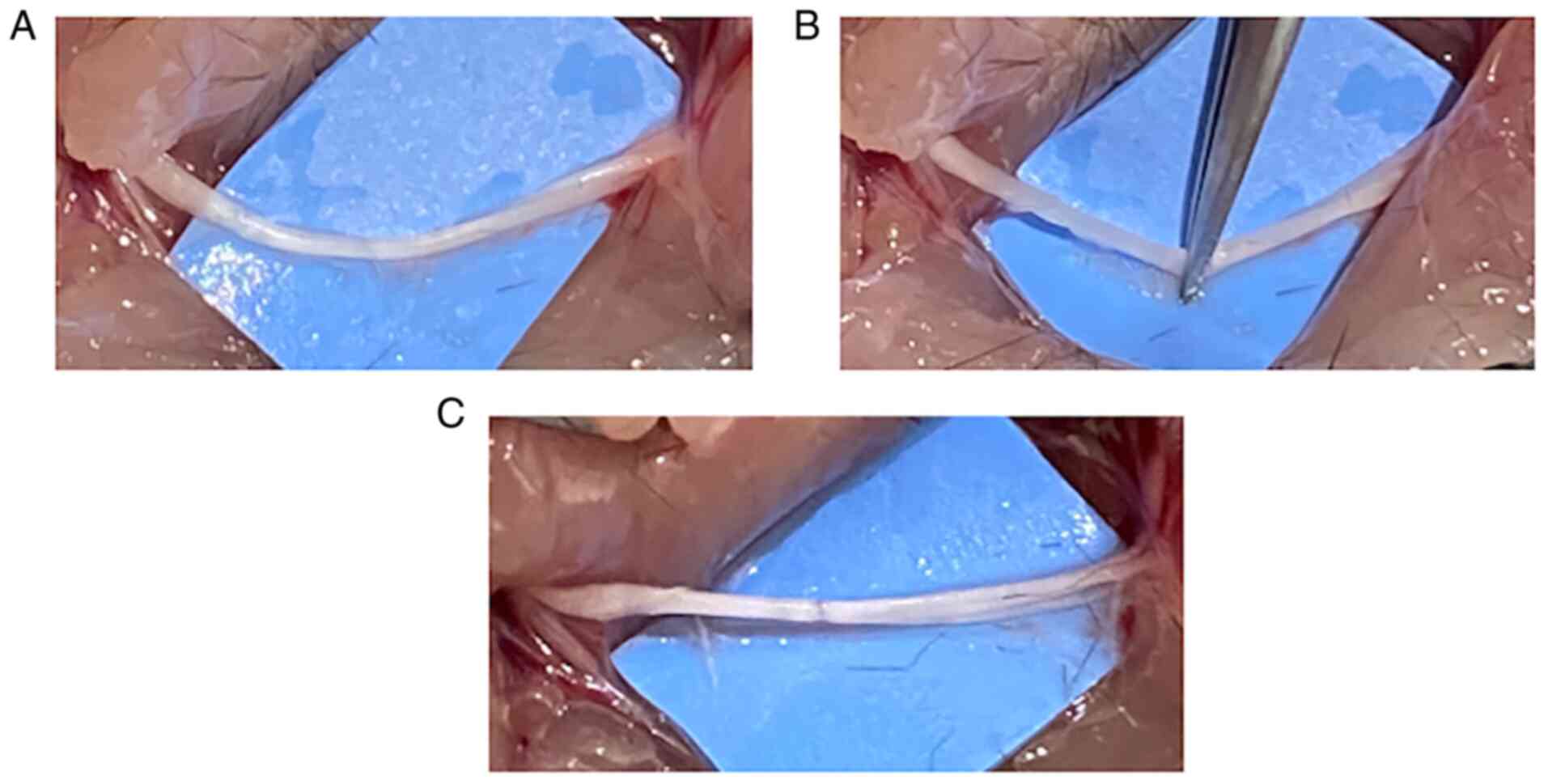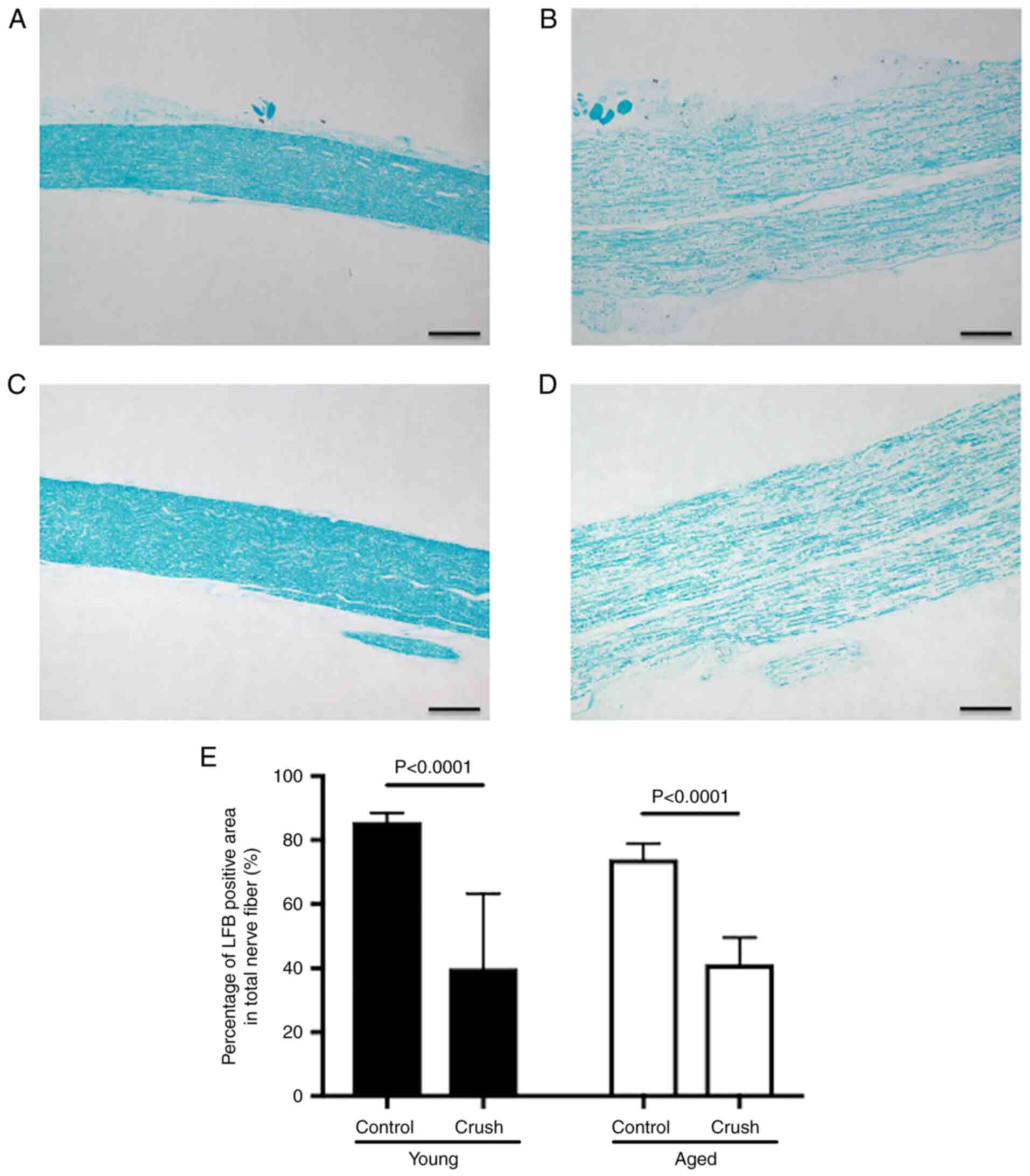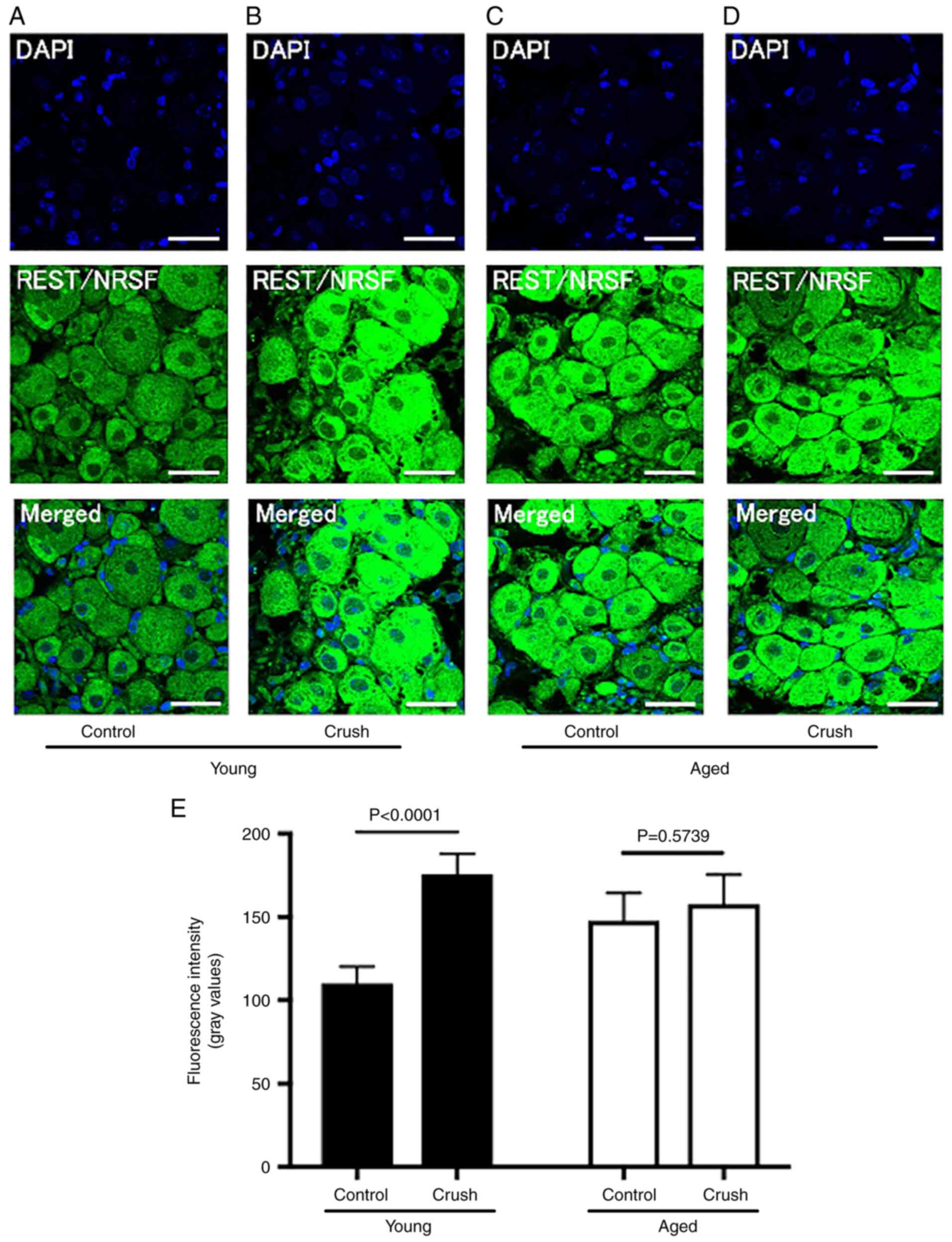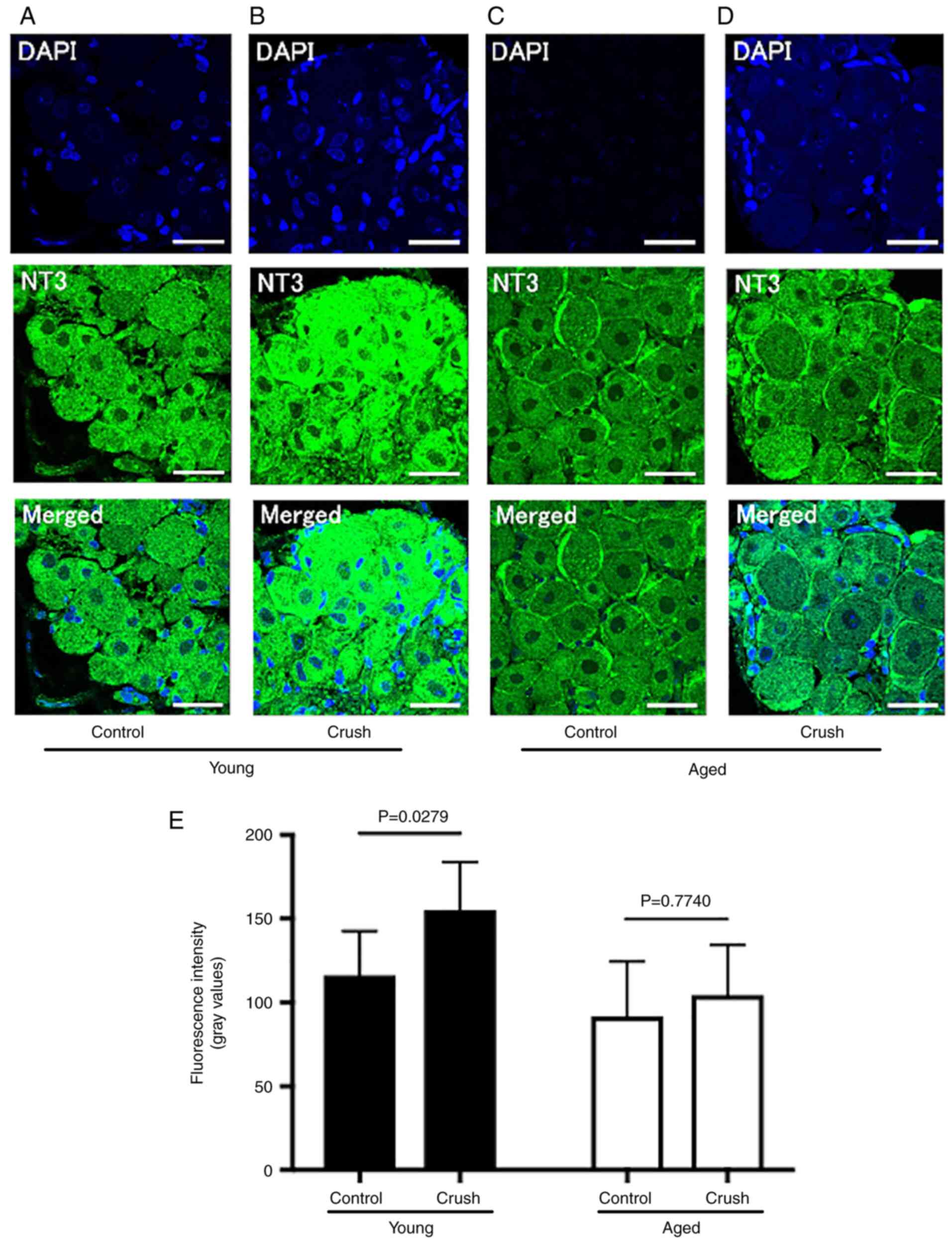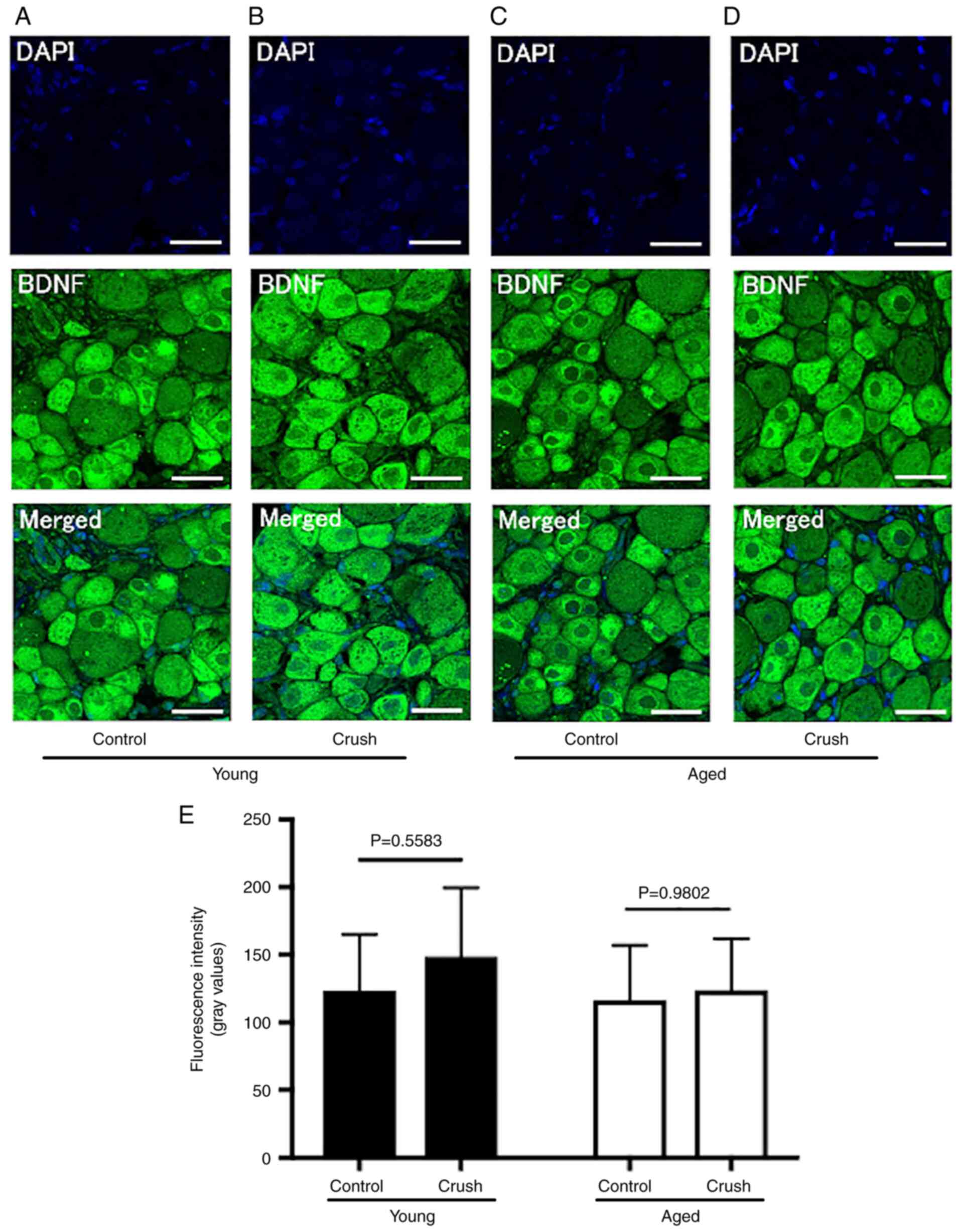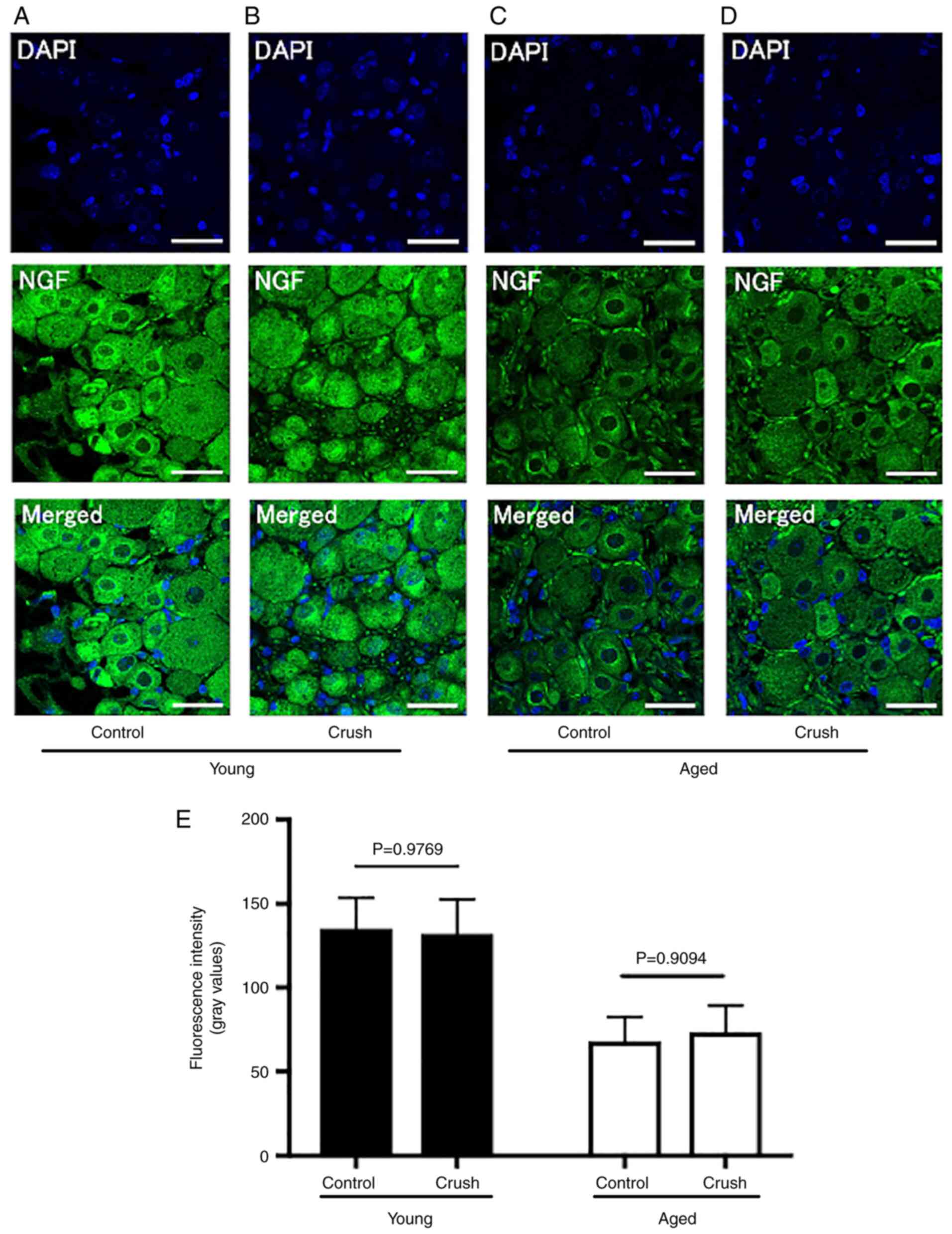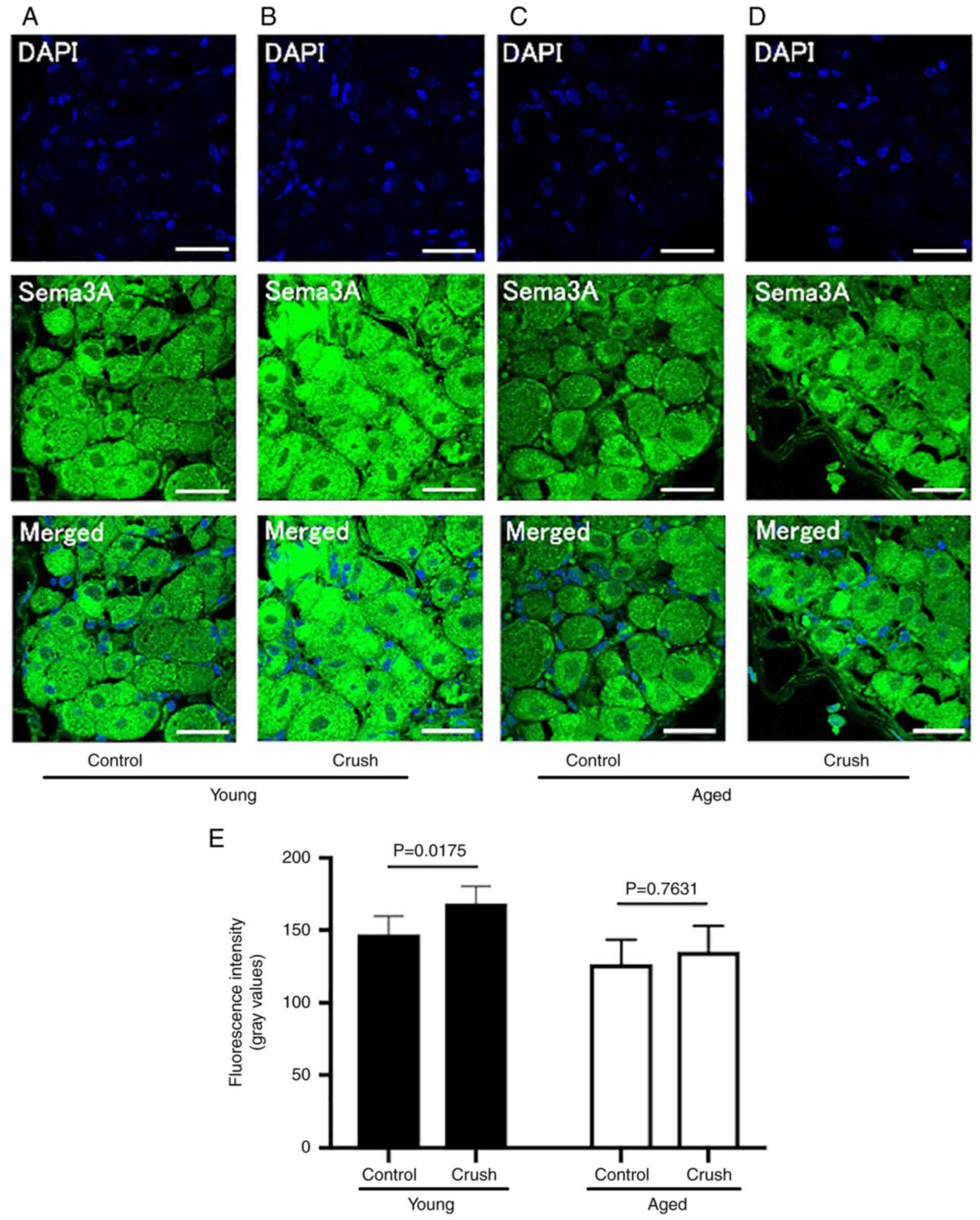|
1
|
Lu T, Aron L, Zullo J, Pan Y, Kim H, Chen
Y, Yang TH, Kim HM, Drake D, Liu XS, et al: REST and stress
resistance in ageing and Alzheimer's disease. Nature. 507:448–454.
2014.PubMed/NCBI View Article : Google Scholar
|
|
2
|
Kawamura M, Sato S, Matsumoto G, Fukuda T,
Shiba-Fukushima K, Noda S, Takanashi M, Mori N and Hattori N: Loss
of nuclear REST/NRSF in aged-dopaminergic neurons in Parkinson's
disease patients. Neurosci Lett. 699:59–63. 2019.PubMed/NCBI View Article : Google Scholar
|
|
3
|
Mampay M and Sheridan GK: REST: An
epigenetic regulator of neuronal stress responses in the young and
ageing brain. Front Neuroendocrinol. 53(100744)2019.PubMed/NCBI View Article : Google Scholar
|
|
4
|
Goto K, Naito K, Nakamura S, Nagura N,
Sugiyama Y, Obata H, Kaneko A and Kaneko K: Protective mechanism
against age-associated changes in the peripheral nerves. Life Sci.
253(117744)2020.PubMed/NCBI View Article : Google Scholar
|
|
5
|
Büttner R, Schulz A, Reuter M, Akula AK,
Mindos T, Carlstedt A, Riecken LB, Baader SL, Bauer R and Morrison
H: Inflammaging impairs peripheral nerve maintenance and
regeneration. Aging Cell. 17(e12833)2018.PubMed/NCBI View Article : Google Scholar
|
|
6
|
Verdú E, Ceballos D, Vilches JJ and
Navarro X: Influence of aging on peripheral nerve function and
regeneration. J Peripher Nerv Syst. 5:191–208. 2000.PubMed/NCBI View Article : Google Scholar
|
|
7
|
Kaneko A, Naito K, Nakamura S, Miyahara K,
Goto K, Obata H, Nagura N, Sugiyama Y, Kaneko K and Ishijima M:
Influence of aging on the peripheral nerve repair process using an
artificial nerve conduit. Exp Ther Med. 21(168)2021.PubMed/NCBI View Article : Google Scholar
|
|
8
|
Chan JR, Cosgaya JM, Wu YJ and Shooter EM:
Neurotrophins are key mediators of the myelination program in the
peripheral nervous system. Proc Natl Acad Sci USA. 98:14661–14668.
2001.PubMed/NCBI View Article : Google Scholar
|
|
9
|
Omura T, Sano M, Omura K, Hasegawa T, Doi
M, Sawada T and Nagano A: Different expressions of BDNF, NT3, and
NT4 in muscle and nerve after various types of peripheral nerve
injuries. J Peripher Nerv Syst. 10:293–300. 2005.PubMed/NCBI View Article : Google Scholar
|
|
10
|
Kim JK, Hann HJ, Kim MJ and Kim JS: The
expression of estrogen receptors in the tenosynovium of
postmenopausal women with idiopathic carpal tunnel syndrome. J
Orthop Res. 28:1469–1474. 2010.PubMed/NCBI View Article : Google Scholar
|
|
11
|
Al-Rousan T, Sparks JA, Pettinger M,
Chlebowski R, Manson JE, Kauntiz AM and Wallace R: Menopausal
hormone therapy and the incidence of carpal tunnel syndrome in
postmenopausal women: Findings from the Women's Health Initiative.
PLoS One. 13(e0207509)2018.PubMed/NCBI View Article : Google Scholar
|
|
12
|
Lee AR, Pechenino AS, Dong H, Hammock BD
and Knowlton AA: Aging, estrogen loss and epoxyeicosatrienoic acids
(EETs). PLoS One. 8(e70719)2013.PubMed/NCBI View Article : Google Scholar
|
|
13
|
Shifren JL and Schiff IJ: The aging ovary.
J Womens Health Gend Based Med. 9 (Suppl 1):S3–S7. 2000.PubMed/NCBI View Article : Google Scholar
|
|
14
|
Schram S, Chuang D, Schmidt G, Piponov H,
Helder C, Kerns J, Gonzalez M, Song F and Loeb JA: Mutant SOD1
prevents normal functional recovery through enhanced glial
activation and loss of motor neuron innervation after peripheral
nerve injury. Neurobiol Dis. 12:469–478. 2019.PubMed/NCBI View Article : Google Scholar
|
|
15
|
Gallaher ZR and Steward O: Modest
enhancement of sensory axon regeneration in the sciatic nerve with
conditional co-deletion of PTEN and SOCS3 in the dorsal root
ganglia of adult mice. Exp Neurol. 303:120–133. 2018.PubMed/NCBI View Article : Google Scholar
|
|
16
|
Lindborg JA, Mack M and Zigmond RE:
Neutrophils are critical for myelin removal in a peripheral nerve
injury model of Wallerian degeneration. J Neurosci. 37:10258–10277.
2017.PubMed/NCBI View Article : Google Scholar
|
|
17
|
Niemi JP, DeFrancesco-Lisowitz A,
Roldán-Hernández L, Lindborg JA, Mandell D and Zigmond RE: A
critical role for macrophages near axotomized neuronal cell bodies
in stimulating nerve regeneration. J Neurosci. 33:16236–16248.
2013.PubMed/NCBI View Article : Google Scholar
|
|
18
|
Apel PJ, Ma J, Callahan M, Northam CN,
Alton TB, Sonntag WE and Li Z: Effect of locally delivered IGF-1 on
nerve regeneration during aging: An experimental study in rats.
Muscle Nerve. 41:335–341. 2010.PubMed/NCBI View Article : Google Scholar
|
|
19
|
Calkins DJ: Age-related changes in the
visual pathways: Blame it on the axon. Invest Ophthalmol Vis Sci.
54:ORSF37–41. 2013.PubMed/NCBI View Article : Google Scholar
|
|
20
|
Bland JD: The relationship of obesity,
age, and carpal tunnel syndrome: More complex than was thought?
Muscle Nerve. 32:527–532. 2005.PubMed/NCBI View Article : Google Scholar
|
|
21
|
Di Caprio F, Meringolo R, Shehab Eddine M
and Ponziani L: Morton's interdigital neuroma of the foot: A
literature review. Foot Ankle Surg. 24:92–98. 2018.PubMed/NCBI View Article : Google Scholar
|
|
22
|
Martínez-Aparicio C, Jääskeläinen SK,
Puksa L, Reche-Lorite F, Torné-Poyatos P, Paniagua Soto J and Falck
B: Constitutional risk factors for focal neuropathies in patients
referred for electromyography. Eur J Neurol. 27:529–535.
2020.PubMed/NCBI View Article : Google Scholar
|
|
23
|
Ransohoff RM: Chemokines and chemokine
receptors: Standing at the crossroads of immunobiology and
neurobiology. Immunity. 31:711–721. 2009.PubMed/NCBI View Article : Google Scholar
|
|
24
|
Benowitz LI and Popovich PG: Inflammation
and axon regeneration. Curr Opin Neurol. 24:577–583.
2011.PubMed/NCBI View Article : Google Scholar
|
|
25
|
Vargas ME, Watanabe J, Singh SJ, Robinson
WH and Barres BA: Endogenous antibodies promote rapid myelin
clearance and effective axon regeneration after nerve injury. Proc
Natl Acad Sci USA. 107:11993–11998. 2010.PubMed/NCBI View Article : Google Scholar
|
|
26
|
Schoenherr CJ and Anderson DJ: The
neuron-restrictive silencer factor (NRSF): A coordinate repressor
of multiple neuron-specific genes. Science. 267:1360–1363.
1995.PubMed/NCBI View Article : Google Scholar
|
|
27
|
Lunyak VV and Rosenfeld MG: No rest for
REST: REST/NRSF regulation of reurogenesis. Cell. 121:499–501.
2005.PubMed/NCBI View Article : Google Scholar
|
|
28
|
Ballas N and Mandel G: The many faces of
REST oversee epigenetic programming of neuronal genes. Curr Opin
Neurobiol. 15:500–506. 2005.PubMed/NCBI View Article : Google Scholar
|
|
29
|
Bruce AW, Donaldson IJ, Wood IC, Yerbury
SA, Sadowski MI, Chapman M, Göttgens B and Buckley NJ: Genome-wide
analysis of repressor element 1 silencing transcription
factor/neuron-restrictive silencing factor (REST/NRSF) target
genes. Proc Natl Acad Sci USA. 101:10458–10463. 2004.PubMed/NCBI View Article : Google Scholar
|
|
30
|
Chong JA, Tapia-Ramírez J, Kim S,
Toledo-AraI JJ, Zheng Y, Boutros MC, Altshuller YM, Frohman MA,
Kraner SD and Mandel G: REST: A mammalian silencer protein that
restricts sodium channel gene expression to neurons. Cell.
80:949–957. 1995.PubMed/NCBI View Article : Google Scholar
|
|
31
|
Zhao Y, Zhu M, Yu Y, Qiu L, Zhang Y, He L
and Zhang J: Brain REST/NRSF is not only a silent repressor but
also an active protector. Mol Neurobiol. 54:541–550.
2017.PubMed/NCBI View Article : Google Scholar
|
|
32
|
Oh YM, Mahar M, Ewan EE, Leahy KM, Zhao G
and Cavalli V: Epigenetic regulator UHRF1 inactivates REST and
growth suppressor gene expression via DNA methylation to promote
axon regeneration. Proc Natl Acad Sci USA. 115:E12417–E12426.
2018.PubMed/NCBI View Article : Google Scholar
|
|
33
|
Zhang F, Gigout S, Liu Y, Wang Y, Hao H,
Buckley NJ, Zhang H, Wood IC and Gamper N: Repressor element
1-silencing transcription factor drives the development of chronic
pain states. Pain. 160:2398–2408. 2019.PubMed/NCBI View Article : Google Scholar
|
|
34
|
Zhang J, Chen SR, Chen H and Pan HL:
RE1-silencing transcription factor controls the acute-to-chronic
neuropathic pain transition and Chrm2 receptor gene expression in
primary sensory neurons. J Biol Chem. 293:19078–19091.
2018.PubMed/NCBI View Article : Google Scholar
|
|
35
|
Ueda H, Kurita JI, Neyama H, Hirao Y,
Kouji H, Mishina T, Kasai M, Nakano H, Yoshimori A and Nishimura Y:
A mimetic of the mSin3-binding helix of NRSF/REST ameliorates
abnormal pain behavior in chronic pain models. Bioorg Med Chem
Lett. 27:4705–4709. 2017.PubMed/NCBI View Article : Google Scholar
|
|
36
|
Richner M, Ulrichsen M, Elmegaard SL, Dieu
R, Pallesen LT and Vaegter CB: Peripheral nerve injury modulates
neurotrophin signaling in the peripheral and central nervous
system. Mol Neurobiol. 50:945–970. 2014.PubMed/NCBI View Article : Google Scholar
|
|
37
|
Park H and Poo MM: Neurotrophin regulation
of neural circuit development and function. Nat Rev Neurosci.
14:7–23. 2013.PubMed/NCBI View Article : Google Scholar
|
|
38
|
Huang EJ and Reichardt LF: Neurotrophins:
Roles in neuronal development and function. Annu Rev Neurosci.
24:677–736. 2001.PubMed/NCBI View Article : Google Scholar
|
|
39
|
Miranda M, Morici JF, Zanoni MB and
Bekinschtein P: Brain-derived neurotrophic factor: A key molecule
for memory in the healthy and the pathological brain. Front Cell
Neurosci. 13(363)2019.PubMed/NCBI View Article : Google Scholar
|
|
40
|
Yang J, Harte-Hargrove LC, Siao CJ,
Marinic T, Clarke R, Ma Q, Jing D, Lafrancois JJ, Bath KG, Mark W,
et al: Hempstead, proBDNF negatively regulates neuronal remodeling,
synaptic transmission, and synaptic plasticity in hippocampus. Cell
Rep. 7:796–806. 2014.PubMed/NCBI View Article : Google Scholar
|
|
41
|
Bhang SH, Jeon O, Choi CY, Kwon YH and Kim
BS: Controlled release of nerve growth factor from fibrin gel. J
Biomed Mater Res A. 80:998–1002. 2007.PubMed/NCBI View Article : Google Scholar
|
|
42
|
Chen ZW and Wang MS: Effects of nerve
growth factor on crushed sciatic nerve regeneration in rats.
Microsurgery. 16:547–551. 1995.PubMed/NCBI View Article : Google Scholar
|
|
43
|
Kemp SW, Webb AA, Dhaliwal S, Dhaliwal S,
Syed S, Walsh SK and Midha R: Dose and duration of nerve growth
factor (NGF) administration determine the extent of behavioral
recovery following peripheral nerve injury in the rat. Exp Neurol.
229:460–470. 2011.PubMed/NCBI View Article : Google Scholar
|
|
44
|
Moattari M, Kouchesfehani HM, Kaka G,
Sadraie SH and Naghdi M: Evaluation of nerve growth factor (NGF)
treated mesenchymal stem cells for recovery in neurotmesis model of
peripheral nerve injury. J Craniomaxillofac Surg. 46:898–904.
2018.PubMed/NCBI View Article : Google Scholar
|
|
45
|
Wu D, Ren Z, Pae M, Guo W, Cui X, Merrill
AH and Meydani SN: Aging up-regulates expression of inflammatory
mediators in mouse adipose tissue. J Immunol. 179:4829–4839.
2007.PubMed/NCBI View Article : Google Scholar
|
|
46
|
Gaudet AD, Popovich PG and Ramer MS:
Wallerian degeneration: Gaining perspective on inflammatory events
after peripheral nerve injury. J Neuroinflammation.
30(110)2011.PubMed/NCBI View Article : Google Scholar
|
|
47
|
Fitzgerald M and McKelvey R: Nerve injury
and neuropathic pain-A question of age. Exp Neurol 275 Pt.
2:296–302. 2016.PubMed/NCBI View Article : Google Scholar
|
|
48
|
Shudo Y, Shimojo M, Fukunaga M and Ito S:
Pituitary adenylate cyclase-activating polypeptide is regulated by
alternative splicing of transcriptional repressor REST/NRSF in
nerve injury. Life Sci. 143:174–181. 2015.PubMed/NCBI View Article : Google Scholar
|
|
49
|
Rose K, Ooi L, Dalle C, Robertson B, Wood
IC and Gamper N: Transcriptional repression of the M channel
subunit Kv7.2 in chronic nerve injury. Pain. 152:742–754.
2011.PubMed/NCBI View Article : Google Scholar
|
|
50
|
Uchida S, Hara K, Kobayashi A, Funato H,
Hobara T, Otsuki K, Yamagata H, McEwen BS and Watanabe Y: Early
life stress enhances behavioral vulnerability to stress through the
activation of REST4-mediated gene transcription in the medial
prefrontal cortex of rodents. J Neurosci. 30:15007–15018.
2010.PubMed/NCBI View Article : Google Scholar
|
|
51
|
Gervasi NM, Dimtchev A, Clark DM, Dingle
M, Pisarchik AV and Nesti LJ: C-terminal domain small phosphatase 1
(CTDSP1) regulates growth factor expression and axonal regeneration
in peripheral nerve tissue. Sci Rep. 11(14462)2021.PubMed/NCBI View Article : Google Scholar
|
|
52
|
Yin Q, Kemp GJ, Yu LG, Wagstaff SC and
Frostick SP: Expression of Schwann cell-specific proteins and
low-molecular-weight neurofilament protein during regeneration of
sciatic nerve treated with neurotrophin-4. Neuroscience.
105:779–783. 2001.PubMed/NCBI View Article : Google Scholar
|















